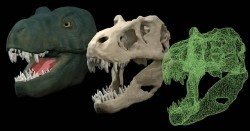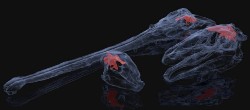Item has been added to bibliography
Please login to use email notification
Please login to use bibliography
TVRG Conference: Jurassic brain teasers – using modern technology to get inside the heads of dinosaurs (and other fossils)
Organised by:
Geological Society Events, Thames Valley Regional Group
Event status:
EVENT CLOSED
Zoom virtual conference - 18.55 for a 19.00 hrs start
Fossils represent physical evidence for the existence of extinct organisms and have vast potential for the study of ancient life. However, the majority of fossils are preserved in the form of hard-tissues (e.g. bones and teeth), while soft-tissues, such as muscles and internal organs, have withered away.
Recent technological advances have revolutionised the field of palaeontology in the last twenty years. New technologies, such as computed tomography (CT) scanning, now allow the visualisation and study of fossils in unprecedented detail. In particular the reconstruction of the brain anatomy holds a vast potential to reconstruct the function and behaviour of fossil organisms. High-resolution models of the brain and associated structures can now be used to explore the sensory and cognitive capabilities of extinct animals, such as dinosaurs.
Although there are still many things that we do not know about life in the past 500 million years, this new field of virtual palaeontology has brought us a lot closer to reconstructing and understanding the biology and ecology of extinct organisms. This talk will explore the new technologies used in modern palaeontology and demonstrate how much information can be obtained from a few “old” bones.


Speaker: Dr Stephan Lautenschlager
Dr Stephan Lautenschlager is a lecturer in Palaeobiology at the University of Birmingham since 2017. His research focusses on developing new approaches to computational palaeobiology and reconstructing fossil organisms. Using novel methods and techniques to study the form and function relationship of extinct organisms, he is interested in how the biomechanics of fossil vertebrates shaped their evolution. After working as a professional software engineer for Siemens Inc., he took a degree in Geology and Palaeontology at Munich University, followed by a PhD and post-doctoral research at the University of Bristol.